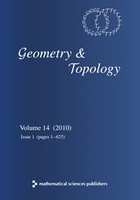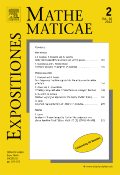
DISCRETE & COMPUTATIONAL GEOMETRY
Scope & Guideline
Innovating Insights into Computational Challenges
Introduction
Aims and Scopes
- Computational Geometry:
The journal extensively covers algorithms, data structures, and computational methods for geometric problems, including Voronoi diagrams, Delaunay triangulations, and geometric optimization. - Discrete Geometry:
It explores the properties and arrangements of geometric objects in discrete settings, including polytopes, lattices, and tilings, emphasizing combinatorial aspects. - Topological Methods:
The journal incorporates research on topology as it relates to geometry, including studies on manifold structures, homology, and persistent homology, which are crucial for understanding geometric configurations. - Geometric Graph Theory:
Papers often focus on properties and algorithms related to graphs embedded in geometric spaces, including visibility graphs, intersection graphs, and geometric representations. - Applications in Data Science:
There is a growing emphasis on applying geometric principles to data analysis, machine learning, and computational biology, particularly through techniques like persistent homology and geometric clustering.
Trending and Emerging
- Persistent Homology and Topological Data Analysis:
This theme has gained momentum due to its applications in data science, particularly in analyzing the shape of data and extracting meaningful patterns from high-dimensional datasets. - Algorithmic Approaches to Geometric Problems:
There is an increasing focus on developing efficient algorithms for complex geometric problems, reflecting the demand for practical solutions in computational geometry. - Geometric Representation and Visualization:
Research on the visualization of geometric structures and their properties is becoming more prominent, addressing the need for better tools in computational geometry and data science. - Interdisciplinary Applications:
The journal is now featuring more interdisciplinary studies that apply geometric techniques to fields such as robotics, computer graphics, and geographic information systems (GIS), illustrating the relevance of geometric research in solving real-world problems. - Higher-Dimensional Geometry:
Exploration of geometric properties in higher-dimensional spaces is increasingly popular, driven by advancements in both theoretical research and practical applications in various scientific fields.
Declining or Waning
- Classical Convexity:
Research focused on classical convexity properties and inequalities has been decreasing as the field shifts towards more complex geometric structures and computational applications. - Static Geometric Structures:
Studies that primarily address static properties of geometric objects without computational implications or applications have become less frequent, as the journal increasingly favors dynamic and algorithmic approaches. - Elementary Geometry:
Traditional topics in elementary geometry, such as basic properties of shapes and figures, are being overshadowed by more advanced computational and topological inquiries.
Similar Journals

GEOMETRY & TOPOLOGY
Charting New Territories in Geometric and Topological ResearchGeometry & Topology is a leading journal in the field of mathematics, focusing on the intricate relationships between geometric structures and topological spaces. Published by Geometry & Topology Publications in the United Kingdom, this prestigious journal boasts an impressive ranking, placing it in the Q1 quartile for Geometry and Topology as of 2023, with a notable Scopus rank of #13 out of 106, indicating its significant impact within the discipline (88th percentile). With publication years spanning from 1997 to 2024, the journal serves as a vital platform for disseminating high-quality research, fostering advances in both theoretical and applied aspects of the field. While it does not currently operate under an Open Access model, it nevertheless attracts the attention of a diverse audience, including researchers, academics, and students eager to explore innovative methodologies and findings in geometry and topology. The journal’s commitment to excellence makes it an essential resource for anyone passionate about mathematical research.

ADVANCES IN GEOMETRY
Advancing Knowledge Through Innovative Geometric ResearchADVANCES IN GEOMETRY is an esteemed journal dedicated to the dissemination of innovative research in the field of geometry and topology. Published by WALTER DE GRUYTER GMBH, this journal serves as a vital platform for researchers and practitioners from around the globe, reflecting the latest advancements and stimulating critical discussions in the subject. With an ISSN of 1615-715X and an E-ISSN of 1615-7168, it enjoys a reputable standing, evidenced by its classification in the Q3 category of the geometry and topology domain according to 2023 metrics. Although the journal operates under standard access options, it is committed to fostering scholarly communication and raising the visibility of high-quality research. The journal's impact on the field is underscored by its Scopus rank of #77 out of 106, placing it in the 27th percentile. Since its inception in 2001, ADVANCES IN GEOMETRY has continually blossomed, promising a convergence of ideas and methodologies that drive forward the understanding of geometric theory. This journal is essential reading for those eager to stay at the forefront of geometry and topology research.

Journal de l Ecole Polytechnique-Mathematiques
Connecting Ideas: The Intersection of Mathematics and Global Impact.Journal de l Ecole Polytechnique-Mathematiques, published by ECOLE POLYTECHNIQUE in France, stands out as a premier platform for disseminating cutting-edge research in the field of mathematics. With an impact factor reflective of its rigorous academic standards, the journal is categorized in the Q1 Quartile for Mathematics as of 2023, placing it among the top tier of scientific publications. Recognized for its strategic focus on various branches of mathematics, it holds a formidable position within Scopus, ranking 94th out of 399 in general mathematics. Since embracing the Open Access model in 2014, the journal has ensured that vital research findings are accessible to a global audience, thereby fostering collaboration and innovation. With convergence expected until 2024, the Journal de l Ecole Polytechnique-Mathematiques continues to be a significant contributor to the academic community, inspiring both seasoned researchers and emerging scholars from around the world.

Beitrage zur Algebra und Geometrie-Contributions to Algebra and Geometry
Unveiling Innovations in Algebra and GeometryBeitrage zur Algebra und Geometrie - Contributions to Algebra and Geometry is a distinguished journal published by Springer Heidelberg, situated in Germany. With a focus on the intricate fields of Algebra and Number Theory and Geometry and Topology, this journal serves as a pivotal platform for the dissemination of innovative research and critical insights from scholars worldwide. Holding a commendable Q3 category ranking in both disciplines as of 2023, it is recognized for its contribution to advancing theoretical foundations and practical applications. The journal has consistently engaged the mathematical community since its inception in 2000, with a specific publication timeline that spans 2000 to 2002 and 2004 to 2024. Despite its absence of open-access options, the journal's articles are pivotal for researchers, professionals, and students seeking authoritative and impactful studies in algebra and geometry. Join an esteemed readership eager to explore and expand upon the boundaries of mathematical inquiry through this exceptional publication.

Aequationes Mathematicae
Fostering Excellence in Mathematical Research Globally.Aequationes Mathematicae is a distinguished academic journal published by SPRINGER BASEL AG, focusing on the dynamic fields of Applied Mathematics, Discrete Mathematics, and Combinatorics. Since its inception in 1968, the journal has served as a vital platform for disseminating high-quality research, with Converged Years expected to extend to 2024. With an impressive Q2 ranking in multiple mathematical disciplines as of 2023, Aequationes Mathematicae is positioned within the top half of its field, reflecting its reputation for excellence. Spanning the globe from its base in Basel, Switzerland, this journal is ideal for researchers, professionals, and students seeking to advance their knowledge and contribute to ongoing discussions within mathematics. While it does not currently offer Open Access options, readers can still access an extensive archive of impactful studies that bolster its standing within the academic community.

SIAM Journal on Applied Algebra and Geometry
Elevating Understanding through Rigorous Mathematical InquirySIAM Journal on Applied Algebra and Geometry, published by SIAM Publications, is a premier academic journal that occupies a vital space in the fields of Algebra, Geometry, and Applied Mathematics. With an impressive impact factor reflected in its Q1 category rankings in 2023 across key mathematical disciplines such as Algebra and Number Theory, as well as Geometry and Topology, this journal is positioned among the highest echelons of mathematical research. Since its inception in 2017, it has become a crucial source for advanced studies and applied techniques that harness algebraic and geometric methods, catering to both theoretical insights and practical applications. Researchers, professionals, and students alike benefit from its rigorous peer-reviewed articles that explore contemporary challenges and developments in mathematics. While Open Access options are currently not available, the journal remains dedicated to fostering innovation and knowledge dissemination within the scientific community, thus ensuring significant contributions to the advancement of the mathematical sciences.

European Journal of Mathematics
Elevating Mathematical Discourse Across BordersWelcome to the European Journal of Mathematics, a prominent publication that serves as a vital platform for disseminating high-quality research in the field of mathematics. Published by Springer International Publishing AG, this journal has witnessed significant growth since its inception in 2015 and is recognized for its contributions within the Q2 category of Mathematics (miscellaneous) as per the 2023 rankings. With an ISSN of 2199-675X and an E-ISSN of 2199-6768, the journal aims to foster innovation and collaboration among researchers, professionals, and students alike. Although it operates under a traditional access model, the journal's commitment to advancing mathematical knowledge and applications cannot be overstated. Positioned among the top-tier publications, the European Journal of Mathematics is an essential resource that encourages the exploration of emerging trends and theories in mathematics, making it indispensable for anyone striving to stay at the forefront of this dynamic field.

Discrete Mathematics Letters
Empowering research through open-access knowledge.Discrete Mathematics Letters is a prominent open-access journal dedicated to advancing the field of Discrete Mathematics and Combinatorics, published by Shahin Digital Publisher. Since its inception in 2019, this journal has rapidly established its presence in the academic community, securing a respectable Q2 category ranking in the 2023 Scopus database, positioning itself at rank #45 out of 92 in its field, making it a valuable resource for researchers and practitioners alike. With a commitment to disseminating high-quality research, Discrete Mathematics Letters provides an accessible medium for sharing innovative ideas and findings within the mathematical sciences, ensuring that researchers, students, and professionals stay informed about the latest developments. As an open-access journal, it provides free access to publications, fostering collaboration and knowledge exchange among the global research community.

EXPOSITIONES MATHEMATICAE
Unveiling New Perspectives in MathematicsEXPOSITIONES MATHEMATICAE, published by Elsevier GmbH, stands as a significant journal in the realm of mathematics, catering primarily to researchers, professionals, and students. With an ISSN of 0723-0869 and an E-ISSN of 1878-0792, this journal has made its mark in the academic community, boasting a Q2 classification in the miscellaneous mathematics category for 2023, illustrating its prominence within its field. The journal addresses a diverse scope of mathematical topics, encouraging the publication of original research and innovative theories while maintaining rigorous academic standards. As it converges from 2004 to 2024, EXPOSITIONES MATHEMATICAE continues to be an essential resource for advancing mathematical knowledge and fostering scholarly communication, despite being a non-open-access publication. Its location in Munich, Germany further anchors it within a rich intellectual tradition, providing accessibility for the mathematical community worldwide.

TRANSACTIONS OF THE AMERICAN MATHEMATICAL SOCIETY
Elevating the Standards of Mathematical ScholarshipTRANSACTIONS OF THE AMERICAN MATHEMATICAL SOCIETY, published by the American Mathematical Society, is a premier journal in the field of mathematics that has been contributing to the advancement of mathematical knowledge since 1900. With an ISSN of 0002-9947 and an E-ISSN of 1088-6850, this journal holds a prestigious position in the academic landscape, evidenced by its Q1 rankings in both Applied Mathematics and Miscellaneous Mathematics categories as of 2023. With a Scopus ranking of #97 in General Mathematics and a percentile standing of 75th, the journal is recognized for its rigorous peer-review process and the quality of the research it publishes. Though it does not currently offer open access options, it essentially serves as a vital resource for researchers, professionals, and students seeking critical insights and developments in mathematical theory and applications. The Transactions aim to publish high-quality research articles that foster the exchange and dissemination of ideas, supporting the growth of both theoretical and applied mathematics within the global scholarly community.